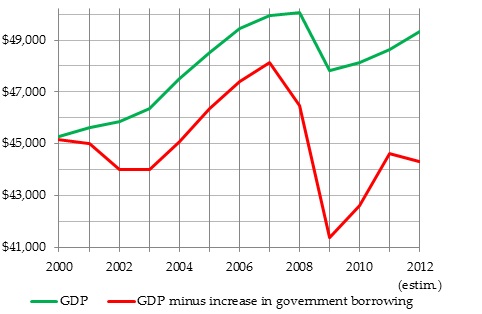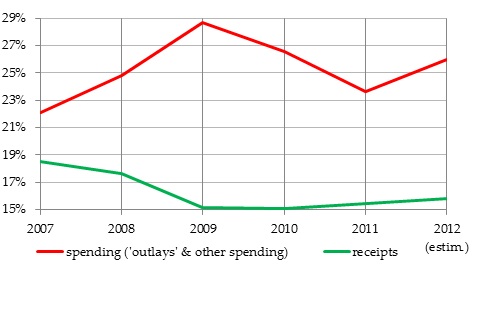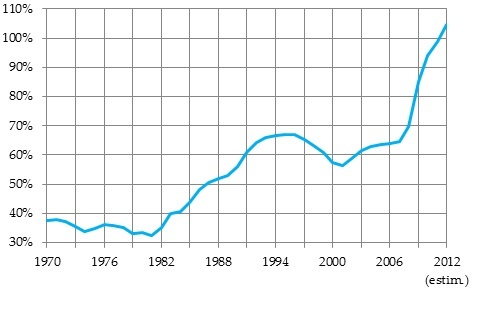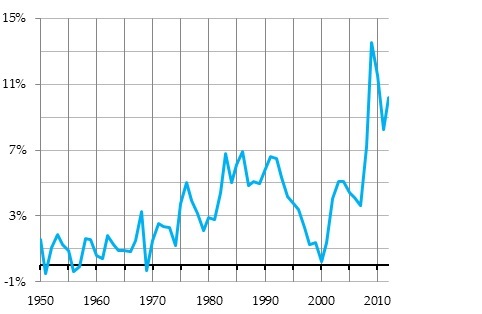This is the first of a series of monthly columns by Andrew Kliman that will be published here in English and at Radikal Portal, a new project, in Norwegian.
January 5, 2013
The dreary and interminable “fiscal cliff” charade is over … for now. But the juvenile political game-playing and brinksmanship—which have been almost constant features of the U.S. political scene for more than a quarter of a century, beginning with the phony Gramm-Rudman-Hollings “balanced budget” act of 1985––will certainly continue. Indeed, in the wake of the fiscal cliff agreement, the outgoing Republican-controlled House of Representatives immediately retaliated by refusing to vote on a $60 billion package of aid to victims of Hurricane Sandy, thousands of whom still lack permanent housing. After this move was widely denounced, Congress did approve a $9.7 billion aid package, but more than a quarter of the Republicans in the House of Representatives voted against it.
What will also continue is the government’s failure to address the profound imbalance between the amount of money it spends and the amount it brings in through taxes. That is because little can be done by means of the usual minor tinkering. Unless a new economic boom comes along to solve the problems, which seems highly unlikely, a solution would require wrenchingly large increases in taxes and/or cuts in spending, especially cuts in the pensions and medical benefits of retired workers (Social Security and Medicare). But there is no will in Washington to impose wrenchingly large changes. Doing so would promptly end the political careers of the politicians who imposed the changes. Moreover, as as I discuss below, the state of the U.S. economy remains too precarious, five years after the Great Recession began, to impose such changes. So we can look forward to more minor tinkering and more game-playing––until the time comes, somewhere down the road, when the bond market from which the U.S. Treasury borrows decides that enough is enough and ends the U.S. Treasury’s access to cheap credit.
It isn’t likely that the bond market will force the government’s hand any time soon. The Treasury is currently able to borrow massively at ridiculously low interest rates; for instance, interest is 0.67% and 1.65% on its five- and ten-year notes, respectively. The low rates are a reflection of the stagnant state of the U.S. and world economies. They are due partly to a serious lack of confidence among lenders––even though lenders are losing money by lending to the Treasury at these rates once inflation is factored in, they do so because they want to park their money in the safest place available. And the low rates are also due partly to quantitative easing–– the money being “printed” by the Federal Reserve to prop up the economy. But unless the current stagnation persists indefinitely, the era of cheap credit will eventually end and the day of reckoning will arrive.
The fiscal cliff deal
In the “fiscal cliff” deal, the President and Congress agreed to terminate the Social Security tax cut. As an anti-recession measure, employees’ Social Security taxes had been 4.2% of their pay during the last two years; the rate will go back to the normal 6.2%. The new law also raises the top income-tax rate from 35% to 39.6%. Although Obama had pushed for higher income taxes on the richest 2% of U.S. tax units, the final measure applies only to the richest 1%, roughly speaking––individuals with incomes above $400,000 and married couples with incomes above $450,000. Other features of the fiscal cliff agreement include money for extended unemployment insurance benefits; modest increases in taxes on inheritances, capital gains, and dividends; and elimination of a couple of tax exemptions and deductions enjoyed by the wealthiest Americans.
However, no deal on the spending side of the budget was reached. We were told that the absence of such a deal would cause us to fall off the fiscal cliff–about $110 billion worth of cuts in government spending would kick in automatically on January 1—but Congress moved the edge of the cliff ahead by two months. And no action was taken to raise the ceiling on Federal government debt. In order to avoid default, the government will have to raise the debt ceiling within the next couple of months. Normally, this is done quietly and uncontroversially, but the era of the Tea Party isn’t a normal one. The brinksmanship that preceded the last rise in the debt ceiling, a year and a half ago, was so severe that the government’s credit rating was cut.
The rise in the income tax on the top 1% of tax units is expected to bring in about $60 billion a year—which reduces the amount of money the government needs to borrow (about $1587 billion in fiscal year 2012) by less than four percent. Despite all that we hear about the richest 1% as the source of America’s problems, it is clear that imposing higher taxes on them is far from a solution to the government’s budgetary gap. The termination of the Social Security tax cut is expected to bring in about $125 billion a year.
These tax increases, especially the termination of the cut in the Social Security tax, will depress economic growth. Nouriel Roubini forecasts that a combination of the tax increases and some government spending cuts later in the year will reduce growth of real gross domestic product (GDP) by about 1.2 percentage points (“US has been let down by its leadership,” Financial Times (ft.com), Jan. 2, 2013). As a result, he and other forecasters expect real GDP to grow even more slowly this year than it did in 2012. (It grew by about 2.3%, about two-thirds of the long-run average.)
U.S. economy on government life-support
Although the fiscal cliff deal does little to address the government’s wildly unbalanced financial situation, measures that would address it in a substantial way are not politically practical at this time, when economic growth is already so sluggish. Such measures would send the economy into another recession. The hard truth is that, even though the Great Recession in the U.S. officially ended three and a half years ago, the economy is still living on government life-support.
As Figure 1 indicates, real GDP per capita has almost recovered to the pre-recession level––last year, it was 1.5% less than in in 2007. But if we subtract additional government borrowing from GDP, in order to get a sense of what GDP per capita would be without the temporary boost provided by additional government indebtedness, we find that it would still be 8% below the 2007 level, and that it would have recovered less than halfway from the fall it underwent between 2007 and 2009. And while unadjusted GDP per capita has risen by 9% since 2000, the adjusted figure remains 2% below its 2000 level. (Literally speaking, my adjustment procedure assumes that the debt multiplier is 1—an extra dollar of government debt boosts GDP (temporarily) by a dollar. But it shouldn’t be taken too literally. It’s just a rough way of gauging the economy’s dependence on government life-support.)
Figure 1. Real Gross Domestic Product Per Capita, U.S.
(constant 2012 dollars)
This life-support has been extremely costly, and it has seriously damaged the Federal government’s financial situation. As Figure 2 shows, even in 2007, before the recession, the government had to borrow an amount equal to 3.6% of GDP, since its spending amounted to 22.1% of GDP while the tax and other receipts it brought in came to only 18.5% of GDP. Then the recession hit. Due to a combination of official “stimulus” measures, falling income, and automatic increases in unemployment insurance benefits and other governmental “transfers” of income, federal government spending rose by 30% between 2007 and 2009 while receipts fell by 18%. This caused the amount of money borrowed by the government to jump to 13.6% of GDP. And the situation hasn’t improved much during the last three years. In 2012, it borrowed an amount equal to 10.2% of GDP–almost triple the 2007 figure–since its spending was 26.0% of GDP while receipts were only 15.8%.
The government’s total debt has risen by a whopping $7.2 trillion, or 78%, since the end of 2007. Between the end of the 2007 and 2012 fiscal years, its debt jumped from 65% of GDP to 105% (see Figure 3). The extra debt amounts to more than $23,000 for every person in the U.S.
Figure 2. Federal Government Spending and Receipts, U.S.
(percentages of GDP)
Figure 3. Gross Federal Debt as Percentage of GDP, U.S.
The huge amount of borrowed money has kept the U.S. economy from spiralling downward into something like the Great Depression, but it hasn’t succeeded in extricating it from a state of near-stagnation. For instance, data released yesterday indicate that the percentage of the U.S. population that has jobs, which plummetted from 62.7% at the end of 2007 to 58.3% at the end of 2009, has scarcely increased since then (see Figure 4). If the employment-to-population continues to rise at the same rate at which it has risen during the last three years, it won’t return to its end-of-2007 level until the end of 2053.
Figure 4. Percentage of Adult Population Employed, U.S.
Three decades of relative stagnation
However, the sorry state of U.S. government finances is due to more than the Great Recession and the failure of the economy to recover in the normal manner since the recession ended. Relative economic stagnation since the 1970s has led to a more or less continual deterioration of its fiscal balance. As I have discussed in The Failure of Capitalist Production (Pluto Books 2012), the U.S. economy, like most of the world economy, failed to fully recover from the global recession of the mid-1970s. Since that time, the growth rates of GDP and income have slowed down markedly, and the slowdown in income growth has tended to depress tax revenue and destabilize the government budget.
In addition, the government has again and again tried to manage, or perhaps solve, the relative stagnation problem by throwing more and more debt at it, further destabilizing its fiscal balance. For example, the entire rise in the ratio of Treasury debt to GDP between 1970 and 2007 is attributable to falling revenue from taxes on corporate income (profit) relative to GDP. (The relative fall in corporate tax revenue is due partly to the fall in the rate of profit, but partly as well to reductions in corporate income tax rates).
Thus, as Figure 5 indicates, while new borrowing by the U.S. Treasury was on average equal to only 1.0% of GDP between 1950 and 1969, it then rose, fairly consistently, during the next quarter century. From 1983 through 1992, it averaged 5.9% of GDP. New borrowing then dropped rapidly during the next eight years, mostly as a result of the dot-com “boom,” but when that “boom” proved to be a bubble that burst, the ratio of new borrowing to GDP rose rapidly once again, even before the Great Recession.
Figure 5. New U.S. Treasury Borrowing
(as percentage of GDP)
The demands to raise taxes on the U.S. working class and cut its retirement and medical benefits have an objective basis. The government’s current fiscal situation is obviously unsustainable, and unless an economic boom comes along to rescue it (which, again, is very unlikely), something has to give. But this doesn’t mean that the proponents of austerity are destined to prevail. The continuing dependence of the U.S. economy on government life-support is an objective reason, from the capitalist perspective, to keep putting off any serious rebalancing of the government’s finances. And politicians don’t want to face the wrath of voters who have seen their taxes raised and benefits cut.
Though there will be some more minor tinkering, I think it is most likely that the opponents of austerity will basically win in the short run. The government’s debt situation will keep worsening as long as it can continue to borrow cheaply. The downside to this, of course, is that when the bond market does eventually decide that enough is enough and a fiscal crisis follows, the continuing run-up of debt will have exacerbated the crisis.
Andrew Kliman
Andrew Kliman is the author of The Failure of Capitalist Production: Underlying Causes of the Great Recession (Pluto Books, 2012) and Reclaiming Marx’s “Capital”: A Refutation of the Myth of Inconsistency (Lexington Books, 2007).






Be the first to comment